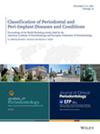Radiographic changes in the maxillary sinus following closed sinus augmentation.
IF 4.2
2区 医学
Q1 DENTISTRY, ORAL SURGERY & MEDICINE
引用次数: 0
Abstract
BACKGROUND The primary objective of this study is to evaluate the accuracy of 3-dimensional (3D) imaging in detecting radiographic and morphological graft changes compared to traditional 2-dimensional (2D) imaging. Additionally, the study aims to assess the distribution of graft material and the extent of resorption occurring between baseline and 6 months post-implant placement following transcrestal sinus augmentation. METHODS This study employed a transcrestal approach utilizing an osseodensification protocol for sinus augmentation with mineralized freeze-dried bone allograft. Immediately post-operatively, a standardized periapical radiograph (PA) was taken using a standardized paralleling device with bite registration material. Furthermore, a low-volume cone beam computed tomography (CBCT) radiograph was obtained. Following a 6-month healing period, both radiographs were repeated for analysis and comparison to baseline parameters. RESULTS A total of 22 subjects completed the study. At 6 months post-surgery, PA evaluations indicated a reduction in apical graft height (AGH) of 55.9%, endo-sinus bone gain (ESBG) reduction of 29.6%, and elevated membrane apex (EMA) reduction of 8.4%. CBCT analysis showed slightly higher reductions, with AGH, ESBG, and EMA reductions of 60.4%, 32.6%, and 12.2%, respectively. A paired t-test comparing the accuracy of the 2D and 3D models' ability to detect changes in graft material resulted in a p-value of 0.2168. CONCLUSIONS Periapical imaging is relatively accurate when standardized, whereas CBCT provides a more precise representation of the graft material distribution and reduction. Significant reductions in AGH, ESBG, and EMA were observed at 6 months, with PAs indicating less change in bone augmentation compared to CBCT. CLINICALTRIALS GOV IDENTIFIER NCT06296459 PLAIN LANGUAGE SUMMARY: The removal of posterior teeth results in expansion of the maxillary sinus, which can limit the bony support for dental implants. To overcome this, the maxillary sinus can be augmented through various techniques and with various materials. This study evaluated augmenting the sinus with a transcrestal approach utilizing a freeze-dried bone allograft. At 6 months postoperatively, x-ray evaluation demonstrated a reduction in graft height and endo-sinus bone gain. Comparison of imaging techniques revealed statistical accuracy of both 2D and 3D models to detect changes in the graft material.上颌窦闭式增强术后的影像学变化。
本研究的主要目的是评估三维(3D)成像与传统二维(2D)成像相比在检测放射学和形态学移植变化方面的准确性。此外,该研究的目的是评估移植材料的分布和吸收的程度发生在基线和6个月的种植体放置后,经瓣窦增强。方法本研究采用矿化冻干同种异体骨移植物经牙槽骨入路,采用骨密度增厚方法进行鼻窦增强。术后立即使用带咬合配准材料的标准化平行装置拍摄标准化根尖周x线片(PA)。此外,还获得了低体积锥束计算机断层扫描(CBCT)。在6个月的愈合期后,重复两张x线片进行分析并与基线参数进行比较。结果共22名受试者完成研究。术后6个月,PA评估显示根尖移植物高度(AGH)降低55.9%,窦内骨增重(ESBG)降低29.6%,膜尖升高(EMA)降低8.4%。CBCT分析显示,AGH、ESBG和EMA的降低幅度略高,分别为60.4%、32.6%和12.2%。配对t检验比较了2D和3D模型检测移植物材料变化能力的准确性,p值为0.2168。结论:标准化后的根尖成像相对准确,而CBCT能更准确地反映移植物材料的分布和复位情况。6个月时观察到AGH、ESBG和EMA的显著降低,与CBCT相比,PAs表明骨增强的变化较小。摘要:拔除后牙导致上颌窦扩张,限制了种植体的骨支撑。为了克服这个问题,上颌窦可以通过各种技术和各种材料来增强。本研究评估了利用冻干同种异体骨移植物经颅入路扩大鼻窦。术后6个月,x线评估显示移植物高度降低,窦内骨增加。成像技术的比较显示了2D和3D模型在检测移植物材料变化方面的统计准确性。
本文章由计算机程序翻译,如有差异,请以英文原文为准。
求助全文
约1分钟内获得全文
求助全文
来源期刊

Journal of periodontology
医学-牙科与口腔外科
CiteScore
9.10
自引率
7.00%
发文量
290
审稿时长
3-8 weeks
期刊介绍:
The Journal of Periodontology publishes articles relevant to the science and practice of periodontics and related areas.
 求助内容:
求助内容: 应助结果提醒方式:
应助结果提醒方式:


